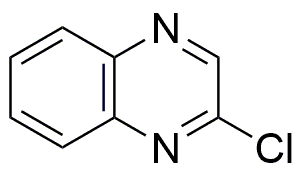2-Chloroquinoxaline is widely utilized in research focused on:
- Pharmaceutical Development: This compound serves as a key intermediate in the synthesis of various pharmaceuticals, particularly in the development of anti-cancer and anti-inflammatory agents.
- Biological Research: It is used in studies to explore its effects on cellular processes, helping researchers understand its potential as a therapeutic agent.
- Material Science: 2-Chloroquinoxaline is employed in the creation of specialized polymers and coatings, enhancing material properties such as durability and resistance to environmental factors.
- Agricultural Chemistry: The compound is investigated for its potential use in developing agrochemicals, contributing to pest control solutions that are more effective and environmentally friendly.
- Analytical Chemistry: It is utilized as a reagent in various analytical techniques, aiding in the detection and quantification of other substances in complex mixtures.
General Information
Properties
Safety and Regulations
Applications
2-Chloroquinoxaline is widely utilized in research focused on:
- Pharmaceutical Development: This compound serves as a key intermediate in the synthesis of various pharmaceuticals, particularly in the development of anti-cancer and anti-inflammatory agents.
- Biological Research: It is used in studies to explore its effects on cellular processes, helping researchers understand its potential as a therapeutic agent.
- Material Science: 2-Chloroquinoxaline is employed in the creation of specialized polymers and coatings, enhancing material properties such as durability and resistance to environmental factors.
- Agricultural Chemistry: The compound is investigated for its potential use in developing agrochemicals, contributing to pest control solutions that are more effective and environmentally friendly.
- Analytical Chemistry: It is utilized as a reagent in various analytical techniques, aiding in the detection and quantification of other substances in complex mixtures.
Documents
Safety Data Sheets (SDS)
The SDS provides comprehensive safety information on handling, storage, and disposal of the product.
Product Specification (PS)
The PS provides a comprehensive breakdown of the product’s properties, including chemical composition, physical state, purity, and storage requirements. It also details acceptable quality ranges and the product's intended applications.
Certificates of Analysis (COA)
Search for Certificates of Analysis (COA) by entering the products Lot Number. Lot and Batch Numbers can be found on a product’s label following the words ‘Lot’ or ‘Batch’.
*Catalog Number
*Lot Number
Certificates Of Origin (COO)
This COO confirms the country where the product was manufactured, and also details the materials and components used in it and whether it is derived from natural, synthetic, or other specific sources. This certificate may be required for customs, trade, and regulatory compliance.
*Catalog Number
*Lot Number
Safety Data Sheets (SDS)
The SDS provides comprehensive safety information on handling, storage, and disposal of the product.
DownloadProduct Specification (PS)
The PS provides a comprehensive breakdown of the product’s properties, including chemical composition, physical state, purity, and storage requirements. It also details acceptable quality ranges and the product's intended applications.
DownloadCertificates of Analysis (COA)
Search for Certificates of Analysis (COA) by entering the products Lot Number. Lot and Batch Numbers can be found on a product’s label following the words ‘Lot’ or ‘Batch’.
*Catalog Number
*Lot Number
Certificates Of Origin (COO)
This COO confirms the country where the product was manufactured, and also details the materials and components used in it and whether it is derived from natural, synthetic, or other specific sources. This certificate may be required for customs, trade, and regulatory compliance.


